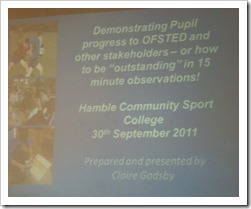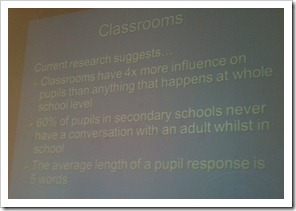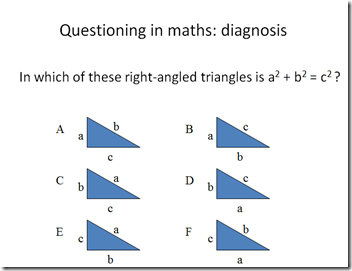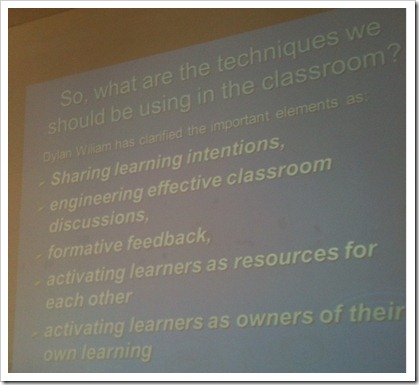 A morning of performance management interviews was followed by a short coffee break, 2 minutes basking in the amazing late autumn heatwave, before all staff made their way to the main hall to take part in Claire Gadsby’s ‘Demonstrating Pupil Progress to OFSTED and Other Stakeholders,’ seminar.
A morning of performance management interviews was followed by a short coffee break, 2 minutes basking in the amazing late autumn heatwave, before all staff made their way to the main hall to take part in Claire Gadsby’s ‘Demonstrating Pupil Progress to OFSTED and Other Stakeholders,’ seminar.
 Introduced by our principal as inspirational speaker, Claire Gadsby certainly held the attention of our staff with her face-paced delivery of high impact educational statistics, effective questioning techniques, inventive classroom progress monitoring strategies that underpinned her ‘Demonstrating Pupil Progress’ agenda.With Ofsted (and the new Ofsted framework) never more than a side step away from the focus of the seminar, she struck right at the heart of what every school is ultimately trying to improve, student attainment. I am hoping that this is emotive opening and that you will will read on, I have shared a range of Claire’s top tips that I intend to ‘road test,’ along with some old favourites, plus a few technology upgrades for the edtech crowd.
Introduced by our principal as inspirational speaker, Claire Gadsby certainly held the attention of our staff with her face-paced delivery of high impact educational statistics, effective questioning techniques, inventive classroom progress monitoring strategies that underpinned her ‘Demonstrating Pupil Progress’ agenda.With Ofsted (and the new Ofsted framework) never more than a side step away from the focus of the seminar, she struck right at the heart of what every school is ultimately trying to improve, student attainment. I am hoping that this is emotive opening and that you will will read on, I have shared a range of Claire’s top tips that I intend to ‘road test,’ along with some old favourites, plus a few technology upgrades for the edtech crowd.
Tap in to the room or quiz before you teach
It’s very simple, simply ask the group what they know about a given topic before you teach it. On a blank sheet of paper, fold in half top to bottom, in half again horizontally, and in half again. Ask the class to write down 8 facts / gems / statistics / information about a given topic.
Alternatively, set a research task, ask students to record as many facts as they can remember about that task. Through conversation with other students in the class, the aim is to fill the gaps on your sheet.
Marking with Success Criteria
Marking is like a rear view mirror. Its already dead, its behind you. After all, do the students really read (or care) about the comments you have written or do they just look for the grade? How to make better use of marked work?
Claire’s tips. Create the success criteria list and share it with the students. Mark to the list.
You did really well on points 2, 3 and 5. Now on point 6 you need to make sure you use ___________. Rewrite the last paragraph addressing this concern. (Or feedback to that effective).
Hereby avoiding the lengthy repetition of similar phrases in numerous exercise books. Of course if all students performance poorly on point 6, check the teaching.
Students Assess Work
Note to self – request students have two pens, or different colour. If all else fails, pencils will do.
As students to Feedback on your Feedback (NEW)
Once a term, ask students to feedback on your feedback. Is the feedback (communication) you send being received and interpreted accurately by the student?
I have asked students to feedback on my teaching, I have asked students to co-create success criteria and terminology for learning, but I have never asked students to feedback on my feedback.
Turn the Stop Clock on Yourself
We often time students on a task. Why not turn the clock on yourself and restrict the time your allow yourself to lead learning? (Bomb or Egg) Alternatively, have a look at the Learning Score (Amazingly FREE for a short period) and co-construct the lesson timings.
Conversation is Vital (NEW)
Try a reverse horse shoe and have all the students face outside (not bad for controlled tasks) and use the time to have a conversation with your students one at a time.
Giant Questions (NEW)
Take an exam questions. Blow it up. Stick ‘em the wall. Now get the students to deconstruct the exam question as a micro presentation. Even gradually add comments, sentences, paragraphs to answer the question.
Post it
Use post-it notes to allow students to feedback everything they know about a particular topic. Then use envoys, room travels, feedback as a competition. See 45, 45, 45 in Quizical.
Allow students to write down questions that they don’t wish to ask out loud in class on a post it. Students stick them to the white / wall / door as they leave. As a lesson starter, provide the answers, even rewarding the best questions. (NEW – music colleague)
30 Questions (NEW)
Create and laminate 30 questions. As students enter the classroom provide each student with a question. Students have to ask their question during the lesson at some point.
Alternatively, set a simple task for students to construct and ask ‘their’ questions to the person sitting next to them or in group situations to facilitate a peer conversation.
Explain it to a 5 Year old (space alien)
I hope that does not need an explanation. Simple, practical and ensures the student reframes their understanding, moving learning towards long term memory.
Audio Feedback
Very useful for online feedback of MFL. Read more here
Randomness (upgrade)
I am passionate about the use of randomness in teach to promote focus and accountability and remove the opportunity to loaf. You have no doubt seen Prof Dylan Williams demonstrate the lollipop picker in the Classroom Experiment, or used ‘old skool’ Spreadsheet name pickers, or seen the fruit machine random name picker. I use the iOS App ‘Teachers pick’ and IMHO it is great value at 59p.
16 Spaces or Classroom Roulette
Create 16 cards numbered. On the board (in your imaginary 4 x 4 grid) mark 11 Q’s, draw 3 stars, 2 zeros. 11 questions correctly answered are worth 1 point each. 3 Stars – are also worth 1 point but no question follows and the big fat zeros reset your score. Feel free to manipulate the scoring. eg add a space – no code – for nothing happens or a double side arrow to accept the answer for a point, or put another team in the dock. Most of the fun is in the discussion on which card to pull off the board and the outcome.
Pupils Annotate their own Work (NEW)
‘I did this because….’ or ‘In this paragraph I tried to….’
Allowing you to understand their thinking more accurately.
Physical Response Answers
Ask a question that has more than one possible answer.
How many tones or voices can you hear in the poem?
Asked the class to stand up, and then asked,
How many of you can hear just one voice, one tone, in the poem? Sit down if ‘one’ is your answer.
Committed by the physical act of sitting down, you can probe further.
Now that you have made your decision, what led you to that conclusion?
Know, Learn, Know Confidently (NEW)
I like the idea of have a list or skills, abilities or attributes a students needs to be able to demonstrate and the physical task of moving them from one column to another.
Multi Choice Questions with Multiple Correct Answers
 Ask questions with more than one correct answer. Do your students really know the answer or was it a lucky guess? Do they really understand the principals your teaching? Well, if there are two correct answers that statistics of getting it right by chance decrease from 1 in 6 of guessing the right answer to a 1 in 15 chance. If there are in fact 3 correct answers…. You need to know, your students know.
Ask questions with more than one correct answer. Do your students really know the answer or was it a lucky guess? Do they really understand the principals your teaching? Well, if there are two correct answers that statistics of getting it right by chance decrease from 1 in 6 of guessing the right answer to a 1 in 15 chance. If there are in fact 3 correct answers…. You need to know, your students know.
More of the topic of proving pupil progress with a random event selector here.
If outstanding lessons include…
…I for one, have a lot to think about…. to grade less, assess more.
Thank you Claire. Some time soon I need to update the Quizical page.
Also worth a read is Tait Coles post, as he looks at the process of students writing the own questions and QFT “Question Formulation Technique.”
[qr_code_display]


This is great K! One variation: instead of asking what students already know about a new topic find out what questions they have. Great use of QTF.
Also, part of our lit policy is that all teachers have a set of green pens to self assess their own work. We have a school wide marking notation that all students are required to use (called PCS code) we don’t mark work which students have not proofread.
Love the comment on my comment. I often do this as a starter: great way of encouraging dialogic learning. Numbering the SC is such a simple obvious idea: I’m definitely going to use that one.
Cheers, D
David, that is really useful feedback. QTF?
Second, when you say self assess their own work? You mean student mark their work – before its ready to be teacher marked? The very thought of a department prerequisite for marking – that students proofread first is powerful. It would be wonderful if you can share the PCS code. I have used Moodle checklist to share success criteria and only mark work that students have signed off through completing the checklist.
Hi Kristian – really interesting post, thank you. There is lots here to take on board and to put in to practice and I agree wholeheartedly with the premises put forward here. I particularly like these ideas too; giving students questions to ask as they walk in plus the deconstruction of exam questions around the room ideas and the ‘explain it to a 5 year old’.
Giving students feedback / assessments that informs their improvement rather than giving them a summative grade is far more important than many people realise. In assessment where I work, we use a system of TIM marking – Triple Impact Marking, ie students assess their own work first, then they submit it whereby we assess it. Then we hand it back, and they feedback again following improvement of the work. That way, students are less likely to focus on that summative grade. Not easy to do all of the time as it is a time consuming activity, however, it is one which results in the best learning, which of course is what we are all here for!
Thanks again for the ideas!
Mark
TIM marking, now thats a very key point. We had a similar discussion in our ICT faculty meeting this afternoon. Large coursework marking, that needs to be self marked and ‘annotated’ before it will be marked by staff. I am not sure students will then feedback a second time, but I am confident the impact would be worth it.
Summative grades, personally, if I were allowed, I would only use them sparingly, I like the no change, + and ++ grading model. Thanks for the dialogue.
QFT. Question Formulation technique: blogged about a week or so ago.
PCS code:
P – punctuation
C – capitals
S – spelling
? – doesn’t make sense
//- new paragraph
Cheers, D
Pingback: Proving Pupil Progress | Look and Learn